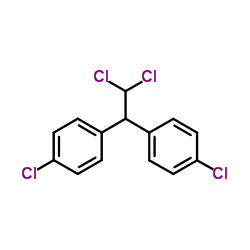p,p'-DDD

p,p'-DDD structure
|
Common Name | p,p'-DDD | ||
|---|---|---|---|---|
| CAS Number | 72-54-8 | Molecular Weight | 320.041 | |
| Density | 1.4±0.1 g/cm3 | Boiling Point | 405.7±40.0 °C at 760 mmHg | |
| Molecular Formula | C14H10Cl4 | Melting Point | 94-96 °C | |
| MSDS | Chinese USA | Flash Point | 199.3±24.7 °C | |
| Symbol |




GHS02, GHS06, GHS08, GHS09 |
Signal Word | Danger | |
Use of p,p'-DDDp,p'-DDD is a major metabolite of p,p'-DDT. p,p'-DDD occurs in the feces and livers of rats, that are given p,p'-DDT by stomach tube, but not of rats injected intraperitoneally with p,p'-DDT[1][2]. |
| Name | ddd |
|---|---|
| Synonym | More Synonyms |
| Description | p,p'-DDD is a major metabolite of p,p'-DDT. p,p'-DDD occurs in the feces and livers of rats, that are given p,p'-DDT by stomach tube, but not of rats injected intraperitoneally with p,p'-DDT[1][2]. |
|---|---|
| Related Catalog | |
| References |
| Density | 1.4±0.1 g/cm3 |
|---|---|
| Boiling Point | 405.7±40.0 °C at 760 mmHg |
| Melting Point | 94-96 °C |
| Molecular Formula | C14H10Cl4 |
| Molecular Weight | 320.041 |
| Flash Point | 199.3±24.7 °C |
| Exact Mass | 317.953674 |
| LogP | 5.39 |
| Vapour Pressure | 0.0±0.9 mmHg at 25°C |
| Index of Refraction | 1.599 |
| Stability | Stable. Incompatible with strong oxidizing agents. |
CHEMICAL IDENTIFICATION
HEALTH HAZARD DATAACUTE TOXICITY DATA
MUTATION DATA
|
| Symbol |




GHS02, GHS06, GHS08, GHS09 |
|---|---|
| Signal Word | Danger |
| Hazard Statements | H225-H301 + H311 + H331-H370-H410 |
| Precautionary Statements | P210-P260-P273-P280-P301 + P310-P311 |
| Personal Protective Equipment | Eyeshields;Faceshields;full-face respirator (US);Gloves;multi-purpose combination respirator cartridge (US) |
| Hazard Codes | T,N,F |
| Risk Phrases | R23/24/25 |
| Safety Phrases | S36/37-S45-S60-S61-S16-S7 |
| RIDADR | UN 2811 6.1/PG 3 |
| WGK Germany | 3 |
| RTECS | KI0700000 |
| Packaging Group | III |
| Hazard Class | 6.1(b) |
| HS Code | 2903999090 |
| HS Code | 2903999090 |
|---|---|
| Summary | 2903999090 halogenated derivatives of aromatic hydrocarbons VAT:17.0% Tax rebate rate:9.0% Supervision conditions:none MFN tariff:5.5% General tariff:30.0% |
|
Risk assessment for children exposed to DDT residues in various milk types from the Greek market.
Food Chem. Toxicol. 75 , 156-65, (2015) The occurrence of residues of DDT and its metabolites was monitored in 196 cow milk samples of various pasteurized commercial types collected from the Greek market. Residue levels were determined by G... |
|
|
Impact of induced fit on ligand binding to the androgen receptor: a multidimensional QSAR study to predict endocrine-disrupting effects of environmental chemicals.
J. Med. Chem. 48 , 5666-74, (2005) We investigated the influence of induced fit of the androgen receptor binding pocket on free energies of ligand binding. On the basis of a novel alignment procedure using flexible docking, molecular d... |
|
|
Role of cytochrome P450s in insecticide resistance: impact on the control of mosquito-borne diseases and use of insecticides on Earth.
Philos. Trans. R. Soc. Lond., B, Biol. Sci. 368(1612) , 20120429, (2013) The fight against diseases spread by mosquitoes and other insects has enormous environmental, economic and social consequences. Chemical insecticides remain the first line of defence but the control o... |
| 1-chloro-4-[2,2-dichloro-1-(4-chlorophenyl)ethyl]benzene |
| EINECS 200-783-0 |
| 4,4'-DDD |
| P,P'-DDD |
| DDD |
| p,p'-Dichlorodiphenyldichloroethane |
| 1,1’-(2,2-dichloroethylidene)bis[4-chlorobenzene] |
| 1,1-Dichloro-2,2-bis(4-chlorophenyl)-ethane |
| 1,1'-(2,2-dichloroethane-1,1-diyl)bis(4-chlorobenzene) |
| 1,1-Bis(4-chlorophenyl)-2,2-dichloroethane |
| p,p'-(Dichlorodiphenyl)dichloroethane |
| 2,2-Bis(4-chlorophenyl)-1,1-dichloroethane |
| DDD, p,p'- |
| Benzene, 1,1'-(2,2-dichloroethylidene)bis[4-chloro- |
| 1,1-Dichloro-2,2-bis(4-chlorophenyl)ethane |
| TDE |
| MFCD00000851 |
| 4,4′-DDD |
| 1,1'-(2,2-Dichloro-1,1-ethanediyl)bis(4-chlorobenzene) |
| Dichlorodiphenyldichloroethane |
| 1,1’-(2,2-dichloroethane-1,1-diyl)bis(4-chlorobenzene) |